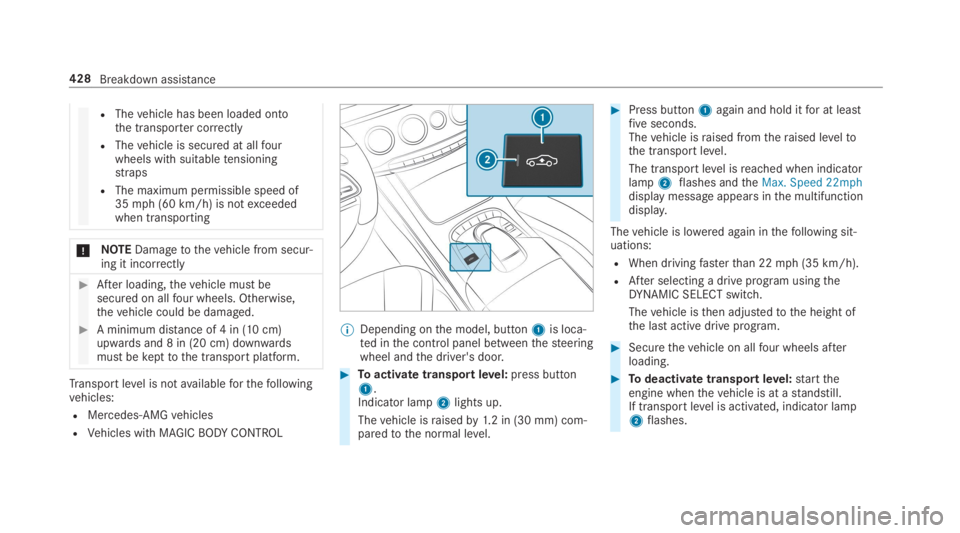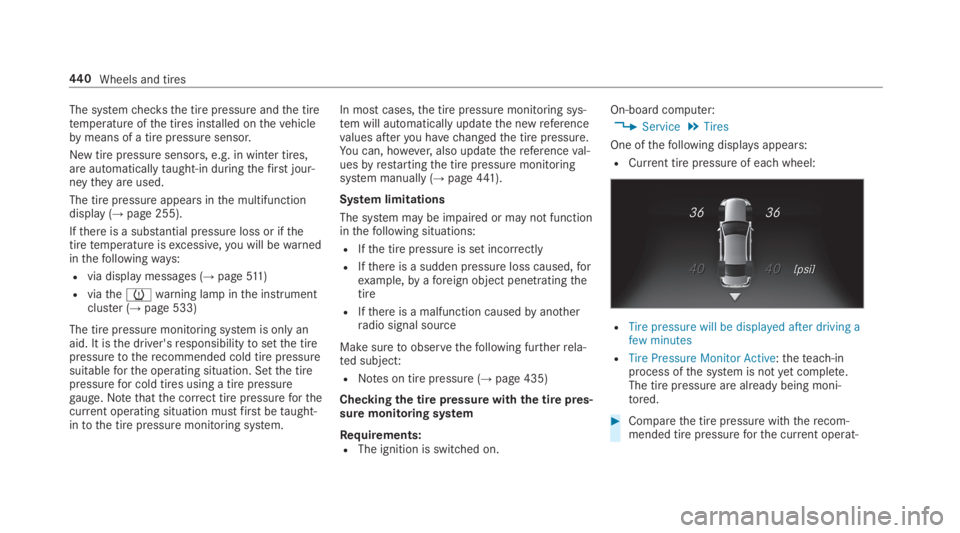2019 MERCEDES-BENZ S CLASS ECU
[x] Cancel search: ECUPage 430 of 578

RThevehicle has been loaded ontothe transporter correctly
RThevehicle is secured at allfourwheels with suitabletensioningstraps
RThe maximum permissible speed of35mph (60 km/h) is notexceededwhen transporting
*NOTEDamagetothevehicle from secur‐ing it incorrectly
#After loading,thevehicle must besecured on allfour wheels. Otherwise,thevehicle could be damaged.
#A minimum distance of 4 in (10 cm)upwards and 8 in (20 cm) downwardsmust bekepttothe transport platform.
Transport level is notavailableforthefollowingvehicles:
RMercedes-AMGvehicles
RVehicles with MAGICBODYCONTROL
%Depending onthe model, button1is loca‐ted inthe control panel betweenthesteeringwheel andthe driver's door.
#Toactivate transportlevel:press button1.Indicator lamp2lights up.
Thevehicle israisedby1.2 in (30 mm) com‐paredtothe normal level.
#Press button1again and hold itfor at leastfiveseconds.Thevehicle israised fromtheraised leveltothe transport level.
The transport level isreached when indicatorlamp2flashes andtheMax. Speed 22mphdisplay message appears inthe multifunctiondisplay.
Thevehicle is lowered again inthefollowing sit‐uations:
RWhen drivingfasterthan 22mph (35 km/h).
RAfter selecting a drive program usingtheDYNAMIC SELECT switch.
Thevehicle isthen adjustedtothe height ofthe last active drive program.
#Securethevehicle on allfour wheels afterloading.
#Todeactivate transportlevel:starttheengine whenthevehicle is at astandstill.If transportlevel is activated, indicator lamp2flashes.
428Breakdown assistance
Page 432 of 578

*NOTEDamageduetoincorrect use ofthetowingeye
When atowingeye is usedtorecover avehi‐cle,thevehicle may be damaged inthe proc‐ess.
#Only usethetowingeyeto towawayortowstartthevehicle.
Tow-startingthevehicle (emergency enginestart)
*NOTEDamagetothe automatic trans‐mission dueto towstarting
The automatic transmission may be damagedinthe process oftowstartingvehicles withautomatic transmission.
#Vehicles with automatic transmissionmust not betowstarted.
#Vehicles with automatic transmission mustnot betow-started.
Electrical fuses
Notes on electrical fuses
&WARNINGRisk of accident and injurydueto overloaded lines
Ifyou manipulate or bridge afaulty fuse or ifyoureplace it with a fuse with a higheramperage,the electric line could beoverloa‐ded.
This couldresult in afire.
#Alwaysreplacefaulty fuses with speci‐fied new fuses containingthe correctamperage.
*NOTEDamagecausedbyincorrect fuses
Incorrect fuses may cause damagetoelectri‐cal components or systems.
#Only use Mercedes-Benz approvedfuses withthe correct fuserating.
Blown fuses mustbereplaced with fuses ofthesamerating, whichyou canrecognizebythecolor and fuserating. The fuseratings and fur‐
ther informationtobe observed are listed inthefuse assignment diagram.
*NOTEDamageor malfunctions causedbymoisture
Moisture may cause damagetothe electricalsystem or cause ittomalfunction.
#Whenthe fuse box is open, make surethat no moisture can enterthe fusebox.
#When closingthe fuse box, make surethatthe seal ofthe lid is positioned cor‐rectly onthe fuse box.
Ifthe newly inserted fuse also blows, havethecause traced andrectified at aqualified special‐istworkshop, e.g. an authorized Mercedes-BenzCenter.
Ensurethefollowing beforereplacing a fuse:
RThevehicle is secured againstrollingaway
RAll electrical consumers are switched off
RThe ignition is switched off
430Breakdown assistance
Page 440 of 578

The tire pressuretable shows therecommendedtire pressurefor all tires approvedforthisvehi‐cle. Therecommended tire pressures applyforcold tires undervarious operating conditions, i.e.loading and/or speed ofthevehicle.
If one or more tire sizes precede a tire pressure,the tire pressure informationfollowing is onlyvalidforthose tire sizes.
The load conditions "partially laden" and "fullyladen" are defined inthetablefor different num‐bersof passengers and amounts of luggage. Theactual number of seats may differ fromthis.
Some tire pressuretables only showtherimdiameter instead ofthe completetire size, e.g.R18. Therim diameter is part ofthe tire size andcan befound onthe tire sidewall (→page449).
Be suretoalso observethefollowing furtherrelated subjects:
RNotes on tire pressure (→page 435)
RTireand Loading Information placard(→page442)
RMaximum tire pressure (→page448)
Checkingtire pressures manually
#Readthe tire pressureforthe current operat‐ing conditions fromtheTireand LoadingInformation placard orthe tire pressuretable. Observethe notes on tire pressure.
#Removethevalve cap ofthe tiretobechecked.
#Pressthe tire pressuregauge securely ontothevalve.
#Readthe tire pressure.
#Ifthe tire pressure is lowerthantherecom‐mendedvalue, increasethe tire pressuretotherecommendedvalue.
#Ifthe tire pressure is higherthantherecom‐mendedvalue,release air.Todo so, pressdownthe metal pin inthevalve, e.g. usingthe tip of a penforexample. Thencheckthetire pressureagain usingthe tire pressuregauge.
#Screwthevalve cap ontothevalve.
438Wheels and tires
Page 442 of 578

The systemchecksthe tire pressure andthe tiretemperature ofthe tires installed onthevehiclebymeans of a tire pressuresensor.
New tire pressure sensors, e.g. in winter tires,are automaticallytaught-in duringthefirst jour‐neytheyare used.
The tire pressure appears inthe multifunctiondisplay (→page 255).
Ifthere is a substantial pressure loss or ifthetiretemperature isexcessive,you will bewarnedinthefollowingways:
Rvia display messages (→page511)
Rviathe�wwarning lamp inthe instrumentcluster (→page 533)
The tire pressuremonitoring system is only anaid. It isthe driver'sresponsibilitytosetthe tirepressuretotherecommended cold tire pressuresuitableforthe operating situation. Setthe tirepressurefor cold tires using a tire pressuregauge. Notethatthe correct tire pressureforthecurrent operating situation mustfirst betaught-intothe tire pressure monitoring system.
In most cases,the tire pressure monitoring sys‐tem will automatically updatethe newreferencevalues afteryou havechangedthe tire pressure.You can, however,also updatethereferenceval‐uesbyrestartingthe tire pressure monitoringsystem manually (→page441).
System limitations
The system may be impaired or may not functioninthefollowing situations:
RIfthe tire pressure is set incorrectly
RIfthere is a sudden pressure loss caused,forexample,byaforeign object penetratingthetire
RIfthere is a malfunction causedbyanotherradio signal source
Make suretoobservethefollowing furtherrela‐ted subject:
RNotes on tire pressure (→page 435)
Checkingthe tire pressure withthe tire pres‐sure monitoring system
Requirements:RThe ignition is switched on.
On-board computer:
,Service.Tires
One ofthefollowing displaysappears:
RCurrent tire pressure of eachwheel:
RTire pressure will be displayed after driving afew minutes
RTire Pressure Monitor Active:theteach-inprocess ofthe system is notyet complete.The tire pressure are already being moni‐tored.
#Comparethe tire pressure withtherecom‐mended tire pressureforthe current operat‐
440Wheels and tires
Page 455 of 578

these are installed onthevehicle, but does notinclude passengers or luggage.
Maximum tire load:the maximum tire load isthe maximum permissibleweight in kilograms orlbsfor whicha tire is approved.
Maximum permissible tire pressure:maxi‐mum permissible tire pressurefor one tire.
Maximum load on one tire:maximum load onone tire. This is calculatedbydividingthe maxi‐mum axle load of one axlebytwo.
PSI (pounds per square inch):standard unit ofmeasurementfor tire pressure.
Aspectratio:ratio between tire height and tirewidth in percent.
Tirepressure:pressure insidethe tire applyingan outwardforcetoeverysquare inch ofthe tire.The tire pressure is specified in pounds persquare inch (psi), in kilopascals (kPa) or in bar.The tire pressure should only be corrected whenthe tires are cold.
Cold tire pressure:the tires are cold whenthevehicle has been parkedfor at least3 hours
without direct sunlight onthe tires orthevehiclehas been drivenfor lessthan 1 mile (1.6 km).
Tirecontact surface:the part ofthe tirethatcomes into contact with theroad.
Tirebead:the purpose ofthe tire bead istoensurethatthe tire sits securely onthe wheelrim. There are several wire cores inthe tire beadtopreventthe tire fromchanging length onthewheelrim.
Sidewall:the part ofthe tire betweenthe treadandthe tire bead.
Weight of optional equipment:the combinedweight ofthe optional equipmentweighing morethanthereplacedstandard parts and morethan5 lbs (2.3kg).This optional equipment, such ashigh-performance brakes, level control system, aroof luggagerackor high-performance batteries,is not included inthe curbweight andtheweightofthe accessories.
TIN (Tire IdentificationNumber):a uniqueidentification number which can be usedby atire manufacturertoidentify tires,forexample,in a productrecall, andthus identifythe pur‐chasers. The TIN is made up ofthe manufactur‐
er's identity code, tire size, tire type code andthe manufacturing date.
Load-bearing index:the load-bearing index is acodethat containsthe maximum load-bearingcapacity of a tire.
Traction:traction isthe gripresulting from fric‐tion betweenthe tires andtheroad surface.
Wear indicator:narrowbars (treadwear bars)that are distributedoverthe tire contact surface.Ifthe tire tread is level withthe bars,thewearlimit of 1/16in (1.6 mm) has beenreached.
Distribution ofvehicle occupants:distributionofvehicle occupantsover designated seat posi‐tions in avehicle.
Maximum permissible payloadweight:nomi‐nal load and luggage load plus150 lb (68kg)multipliedbythe number of seats inthevehicle.
Wheels and tires453
Page 478 of 578

Vehicle dimensions
Sedan
Vehicle length201.8 in(5125 mm)
Vehicle width including out‐side mirrors83.9 in(2130 mm)
Vehicle width without outsidemirrors74.8 in(1899 mm)
Wheelbase119.5 in(3035 mm)
Long wheelbasevehicles
Vehicle length206.9 in(5255 mm)
Vehicle width including out‐side mirrors83.9 in(2130 mm)
Vehicle width without outsidemirrors74.8 in(1899 mm)
Wheelbase124.6 in(3165 mm)
Mercedes‑Maybach
Vehicle length215in(5462 mm)
Vehicle width including out‐side mirrors83.9 in(2130 mm)
Vehicle width without outsidemirrors74.8 in(1899 mm)
Wheelbase132.5 in(3365 mm)
Vehicle height
Sedan
S 450 4MATIC 58.9 in (1496 mm)
S 560 4MATIC 59.0 in (1499 mm)
Long wheelbasevehicles
S 450 4MATIC
S 450
58.8 in (1494 mm)
Allother models 58.9 in (1497 mm)
Mercedes‑Maybach
All models59 in (1498 mm)
Weights and loads
Please notethatforthe specifiedvehicle data:
Ritems of optional equipment increasethecurbweight andreducethe payload.
476Technical data
Page 491 of 578

Display messagesPossible causes/consequences and�P�PSolutions
Left Side Curtain AirbagMalfunction ServiceRequired(Example)
&WARNINGRisk of injuryorfatal injury duetomalfunctions inthe window airbag
Ifthe window airbag is malfunctioning, it might be triggered unintentionally or might not be triggered at all intheevent of an accident with high deceleration.
#Havethe window airbagchecked andrepaired immediately at aqualified specialistworkshop.
#Visit aqualified specialistworkshop immediately.
Front Passenger AirbagEnabled See Operator'sManual
*The front passenger airbag and knee airbags are enabled duringthe journey:
Reven when achild, a small adult or an objectweighing lessthanthe systemweightthreshold is located onthefront passenger seat
Reven whenthe front passenger seat is not occupied
The system may detect objects orforcesthat are addingtotheweight appliedtothe seat.
&WARNINGRisk of injuryorfatal injury when using achildrestraint system whilethe front passenger air bagis enabled
Ifyou secure achild in achildrestraint system onthe front passenger seat andthe front passenger air bag isenabled,the front passenger air bag can deploy intheevent of an accident.
Thechild could bestruckbythe air bag.
#Ensure, bothbefore and duringthe journey,thatthestatus ofthe front passenger air bag is correct.
Display messages andwarning/indicator lamps489
Page 544 of 578

Seat belts ............................................41 0Seat cover ............................................41 0Sensors............................................... 409Tailpipes .............................................. 409Washingbyhand ................................. 404Wheels/rims ....................................... 409Windows.............................................. 409Wiper blades .......................................409
Carpet (Care)............................................41 0
Champagneglass....................................131
Change of address.....................................21
Change ofownership................................21
Changing a wheelPreparation .........................................458Raisingthevehicle .............................. 459
Changinggears........................................178Manually ..............................................178
Changing hub caps.................................458
Character entryOnthetouchpad .................................286Usingthe controller ............................. 286
ChargingBattery (vehicle) ..................................423
Mobile phone (wireless) .......................141USB port ..............................................138
Chassis level (MAGICBODYCON‐TROL)Setting .................................................221
Chauffeur mode......................................... 99Fullyreclined position ..........................104Information ............................................ 99Installing/removing headrestraint ......101Movingthe front passenger seat intothechauffeur position .........................100Movingthe front passenger seat intothe normal position .............................102
Child safety lockActivating/deactivating (multimediasystem) ............................................... 293Rear door .............................................. 59Rear side windows................................. 60
Child seatAttaching (notes) ................................... 52Basic instructions ..................................47front-passenger seat (notes) ..................57LATCH-type (ISOFIX) (installing) ............ 53Notes onrisks and dangers ...................48
Securing onthe front passenger seat ....58Securing ontherear seat ...................... 56TopTether ..............................................55
ChildrenAvoiding dangers inthevehicle .............48Basic instructions ..................................47Special seat beltretractor ..................... 53
Chock....................................................... 457Storage location ..................................457
Chocksee Chock
CigarettelighterFront center console ...........................13 5Rear passenger compartment .............135
Cleaningsee Care
Climate controlActivating/deactivatingthe A/Cfunction (control panel) .......................160Activating/deactivatingthe A/Cfunction (multimedia system) ..............16 0Activating/deactivatingthe synchro‐nization function (multimedia sys‐tem) .....................................................16 2
542Index